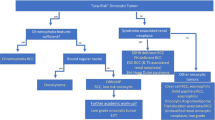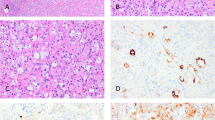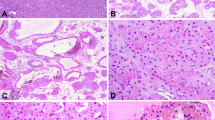Abstract
MOST pathologists will agree that the histogenesis of the so-called Grawitz tumours of the kidney was settled by the classical paper of Stoerk published in 19081; but the arguments of this author, convincing as they were in disproving the suprarenal nature of the ‘hypernephroma’, were much less so in demonstrating their renal origin. That is the reason why this latter opinion has been challenged time and again. New theories have been put forward, among which those of Apitz2 and of Feyrter3 have attracted some attention lately.
This is a preview of subscription content, access via your institution
Access options
Subscribe to this journal
Receive 51 print issues and online access
$199.00 per year
only $3.90 per issue
Buy this article
- Purchase on Springer Link
- Instant access to full article PDF
Prices may be subject to local taxes which are calculated during checkout
Similar content being viewed by others
References
Stoerk, O., Beitr. Anat. und Allg. Path., 43, 393 (1908).
Apitz, K., Virch. Arch., 311, 285 (1943).
Feyrter, F., “Über diffuse endokrine epitheliale Organe” (J. A. Barth, Leipzig, 1938).
Pease, D. C., J. Biophys. Biochem. Cytol., 2 (Supp.), 203 (1956).
Author information
Authors and Affiliations
Rights and permissions
About this article
Cite this article
OBERLING, C., RIVIÈRE, M. & HAGUENAU, F. Ultrastructure of the Clear Cells in Renal Carcinomas and its Importance for the Demonstration of their Renal Origin. Nature 186, 402–403 (1960). https://doi.org/10.1038/186402a0
Issue Date:
DOI: https://doi.org/10.1038/186402a0
This article is cited by
-
Landmarks in the diagnosis and treatment of renal cell carcinoma
Nature Reviews Urology (2014)
-
Changes in the expression and subcellular distribution of galectin-3 in clear cell renal cell carcinoma
Journal of Experimental & Clinical Cancer Research (2011)
-
ARPP protein is selectively expressed in renal oncocytoma, but rarely in renal cell carcinomas
Modern Pathology (2007)
-
Ultrastructure of streptozotocin ? induced renal tumours in mice
Virchows Archiv (1997)
Comments
By submitting a comment you agree to abide by our Terms and Community Guidelines. If you find something abusive or that does not comply with our terms or guidelines please flag it as inappropriate.



